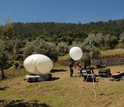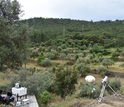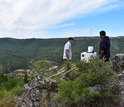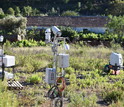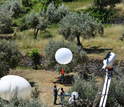News Release 17-048
Atmospheric scientists conduct field experiment to study wind flow over complex mountain terrain
Results will benefit weather forecasting and wind energy efforts
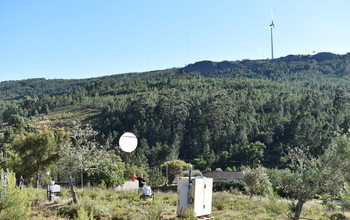
Perdigão scientists study valley meteorology and the "wake" of the wind turbine.
June 1, 2017
This material is available primarily for archival purposes. Telephone numbers or other contact information may be out of date; please see current contact information at media contacts.
Over the past month, researchers have descended on Portugal's Vale Do Cobrão near the Spanish border to study the valley's wind flow patterns.
The international project, known as Perdigão after the closest town, is funded by the National Science Foundation (NSF) and involves more than 50 atmospheric scientists. They're working to better understand how wind moves over variable terrain.
The project began on May 1 and will continue until June 15.
"The Perdigão field experiment is an impressive effort that involves U.S. researchers and their colleagues in Europe," said Nick Anderson, program director in NSF's Division of Atmospheric and Geospace Sciences, which funds Perdigão. "Data from Perdigão's instrument array will improve our understanding of wind flow over complex terrain, with benefits to weather forecasting and wind energy."
The United States and the European Union have expressed interest in increasing wind energy shares of their respective total energy consumption. Doing so will require updated models for a more detailed and accurate understanding of wind flow in natural settings, scientists say.
The research promises to improve assessments of wind resources in Europe and elsewhere, and to help determine optimal sites for building wind turbines. Scientists at the Perdigão site are using an existing, full-scale turbine to study interactions of the turbine with varying wind flows and topography.
Vale Do Cobrão, which stretches between two parallel ridges, is a mosaic of farmland, vegetation, canyons, gullies and a river. The valley's wind flow is usually perpendicular to the ridges, but can reverse and build to powerful gusts. The researchers' instruments are collecting data on wind flow, including velocity, turbulence, temperature, moisture and radiation.
The Perdigão project is a paradigm shift from previous field studies, according to Harindra Fernando, principal investigator of the study for the U.S. group and a scientist at the University of Notre Dame.
"Perdigão is a leap forward from the early wind flow experiments conducted in the late 1970s," Fernando said. "Those studies focused on wind flow over a single hill. The resulting data have been, and continue to be, heavily used today."
Perdigão's U.S. group includes researchers from the University of Colorado Boulder, Cornell University, the University of Oklahoma, University of California, Berkeley, and the Army Research Laboratory. The NSF-funded National Center for Atmospheric Research is providing equipment and logistical and scientific data support.
Perdigão capitalizes on recent technological advances in remote sensing. It includes 30 scanning and profiling units to map the valley's atmosphere, Fernando said. Researchers will map the flow field in greater detail using improved models and a new understanding of wind flow based on the new data set.
Along an estimated 4-mile-long, 1-mile-wide swath of the valley, researchers have set up an array of instruments, including approximately 50 towers ranging in height from 10 to 100 meters. The towers are equipped with sonic anemometers to measure air flow and turbulence.
Thermistor arrays, microwave radiometers and an Atmospheric Emitted Radiance Interferometer (AERI) measure temperature structure. LI-COR systems measure carbon dioxide and water vapor, while radiometers measure the incoming, outgoing and net radiation.
The scientists have set up remote sensors that use technology such as SODAR (SOnic Detection And Ranging), LIDAR (Light Detection And Ranging) and wind profilers to capture flow measurements.
In addition, four to 16 radio soundings are being deployed to map the atmospheric structure in and above the valley. Additional equipment will track fine-scale turbulence, pressure perturbations, lower atmospheric meteorological profiles and acoustic levels.
By the end of the project, the scientists will have obtained the most advanced wind flow data to date.
-NSF-
-
The release of a meteorological instrument called a radiosonde, which ascends tens of kilometers.
Credit and Larger Version -
Perdigão project instruments arrayed on a northern slope outside a valley.
Credit and Larger Version -
A scanning LIDAR measures wind velocity and turbulence. A wind turbine is in the background.
Credit and Larger Version -
LIDAR and aerosol-sensing instruments at the Perdigão site; LIDAR maps the wind flow field.
Credit and Larger Version -
Release of a radiosonde for meteorological measurements from a Perdigão research site.
Credit and Larger Version
Media Contacts
Cheryl Dybas, NSF, (703) 292-7734, email: cdybas@nsf.gov
Jessica Sieff, University of Notre Dame, (574) 631-3933, email: jsieff@nd.edu
Related Websites
Perdigao Field Experiment: https://www.eol.ucar.edu/field_projects/perdig%C3%A3o
The U.S. National Science Foundation propels the nation forward by advancing fundamental research in all fields of science and engineering. NSF supports research and people by providing facilities, instruments and funding to support their ingenuity and sustain the U.S. as a global leader in research and innovation. With a fiscal year 2023 budget of $9.5 billion, NSF funds reach all 50 states through grants to nearly 2,000 colleges, universities and institutions. Each year, NSF receives more than 40,000 competitive proposals and makes about 11,000 new awards. Those awards include support for cooperative research with industry, Arctic and Antarctic research and operations, and U.S. participation in international scientific efforts.
Connect with us online
NSF website: nsf.gov
NSF News: nsf.gov/news
For News Media: nsf.gov/news/newsroom
Statistics: nsf.gov/statistics/
Awards database: nsf.gov/awardsearch/
Follow us on social
Twitter: twitter.com/NSF
Facebook: facebook.com/US.NSF
Instagram: instagram.com/nsfgov



